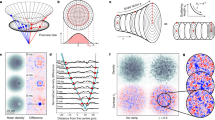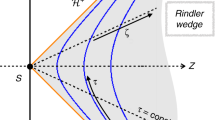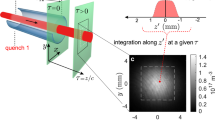Abstract
The exploration of quantum phenomena in a curved spacetime is an emerging interdisciplinary area at the interface between general relativity1,2,3,4, thermodynamics4,5,6 and quantum information7,8. One famous prediction in this field is Unruh thermal radiation3—the manifestation of thermal radiation from a Minkowski vacuum when viewed in an accelerating reference frame. Here, we report the experimental observation of a matter field with thermal fluctuations that agree with Unruh’s predictions. The matter field is generated within a framework for the simulation of quantum physics in a non-inertial frame, based on Bose–Einstein condensates that are parametrically modulated9 to make their evolution replicate the frame transformation. We further observe long-range phase coherence and temporal reversal of the matter-wave radiation, hallmarks that distinguish Unruh radiation from its classical counterpart. Our demonstration offers a new avenue for the investigation of the dynamics of quantum many-body systems in a curved spacetime.
This is a preview of subscription content, access via your institution
Access options
Access Nature and 54 other Nature Portfolio journals
Get Nature+, our best-value online-access subscription
$29.99 / 30 days
cancel any time
Subscribe to this journal
Receive 12 print issues and online access
$209.00 per year
only $17.42 per issue
Buy this article
- Purchase on Springer Link
- Instant access to full article PDF
Prices may be subject to local taxes which are calculated during checkout




Similar content being viewed by others
Data availability
The data that support the plots within this paper and other findings of this study are available from the corresponding author on reasonable request.
References
Hawking, S. W. Black hole explosions? Nature 248, 30–31 (1974).
Hawking, S. W. Particle creation by black holes. Commun. Math. Phys. 43, 199–220 (1975).
Unruh, W. G. Notes on black-hole evaporation. Phys. Rev. D 14, 870–892 (1976).
Wald, R. M. Quantum Field Theory in Curved Spacetime and Black Hole Thermodynamics (University of Chicago Press, 1994).
Bekenstein, J. D. Black holes and entropy. Phys. Rev. D 7, 2333–2346 (1973).
Hawking, S. W. Black holes and thermodynamics. Phys. Rev. D 13, 191–197 (1976).
Hayden, P. & Preskill, J. Black holes as mirrors: quantum information in random subsystems. J. High Energy Phys. 2007, 120 (2007).
Giddings, S. B. Black holes, quantum information, and the foundations of physics. Phys. Today 66, 30 (2013).
Clark, L. W., Gaj, A., Feng, L. & Chin, C. Collective emission of matter-wave jets from driven Bose-Einstein condensates. Nature 551, 356–359 (2017).
Maldacena, J. The large n limit of superconformal field theories and supergravity. Adv. Theor. Math. Phys. 2, 213–252 (2018).
Hawking, S. W. Breakdown of predictability in gravitational collapse. Phys. Rev. D 14, 2460–2473 (1976).
Susskind, L. The paradox of quantum black holes. Nat. Phys. 2, 665–677 (2006).
Almheiri, A., Marolf, D., Polchinski, J. & Sully, J. Black holes: complementarity or firewalls? J. High Energy Phys. 2013, 62 (2013).
Su, D., Ho, C. T. M., Mann, R. B. & Ralph, T. C. Quantum circuit model for non-inertial objects: a uniformly accelerated mirror. New J. Phys. 19, 063017 (2017).
Chin, C., Grimm, R., Julienne, P. & Tiesinga, E. Feshbach resonances in ultracold gases. Rev. Mod. Phys. 82, 1225–1286 (2010).
Nguyen, J. H. V. et al. Parametric excitation of a Bose-Einstein condensate: from Faraday waves to granulation. Phys. Rev. X 9, 011052 (2019).
Feng, L., Hu, J., Clark, L. W. & Chin, C. Correlations in high-harmonic generation of matter-wave jets revealed by pattern recognition. Science 363, 521–524 (2019).
Langen, T., Geiger, R., Kuhnert, M., Rauer, B. & Schmiedmayer, J. Local emergence of thermal correlations in an isolated quantum many-body system. Nat. Phys. 9, 640–643 (2013).
Howell, J. C., Bennink, R. S., Bentley, S. J. & Boyd, R. W. Realization of the Einstein-Podolsky-Rosen paradox using momentum- and position-entangled photons from spontaneous parametric down conversion. Phys. Rev. Lett. 92, 210403 (2004).
Zheng, Y., Ren, H., Wan, W. & Chen, X. Time-reversed wave mixing in nonlinear optics. Sci. Rep. 3, 3245 (2013).
Linnemann, D. et al. Quantum-enhanced sensing based on time reversal of nonlinear dynamics. Phys. Rev. Lett. 117, 013001 (2016).
Linnemann, D. et al. Active SU(1,1) atom interferometry. Quantum Sci. Technol. 2, 044009 (2017).
Garay, L. J., Anglin, J. R., Cirac, J. I. & Zoller, P. Sonic analog of gravitational black holes in Bose-Einstein condensates. Phys. Rev. Lett. 85, 4643–4647 (2000).
Schützhold, R. & Unruh, W. G. Hawking radiation in an electromagnetic waveguide. Phys. Rev. Lett. 95, 031301 (2005).
Horstmann, B., Reznik, B., Fagnocchi, S. & Cirac, J. I. Hawking radiation from an acoustic black hole on an ion ring. Phys. Rev. Lett. 104, 250403 (2010).
Bekenstein, R., Schley, R., Mutzafi, M., Rotschild, C. & Segev, M. Optical simulations of gravitational effects in the Newton-Schrödinger system. Nat. Phys. 11, 872–878 (2015).
Steinhauer, J. Observation of quantum Hawking radiation and its entanglement in an analogue black hole. Nat. Phys. 12, 959–965 (2016).
Rodríguez-Laguna, J., Tarruell, L., Lewenstein, M. & Celi, A. Synthetic Unruh effect in cold atoms. Phys. Rev. A 95, 013627 (2017).
Feng, L., Clark, L. W., Gaj, A. & Chin, C. Coherent inflationary dynamics for Bose-Einstein condensates crossing a quantum critical point. Nat. Phys. 14, 269–272 (2018).
Wang, X.-B., Hiroshima, T., Tomita, A. & Hayashi, M. Quantum information with gaussian states. Phys. Rep. 448, 1–111 (2007).
Clark, L. W. et al. Observation of density-dependent gauge fields in a Bose-Einstein condensate based on micromotion control in a shaken two-dimensional lattice. Phys. Rev. Lett. 121, 030402 (2018).
Acknowledgements
We thank R. M. Wald, N. D. Gemelke and L. W. Clark for helpful discussions and reading the manuscript. We thank K. Levin’s group for providing the numerical solver. We thank F. Fung for graphics preparation. L.F. acknowledges support from an MRSEC-funded graduate research fellowship. This work is supported by National Science Foundation (NSF) grant no. PHY-1511696, the Army Research Office Multidisciplinary Research Initiative under grant W911NF-14-1-0003 and the University of Chicago Materials Research Science and Engineering Center, which is funded by the NSF under grant no. DMR-1420709.
Author information
Authors and Affiliations
Contributions
J.H. proposed this idea. J.H., L.F. and Z.Z. performed the experiments, built the theoretical model and analysed the data. C.C. supervised the work. All the authors contributed to discussing the results and writing the manuscript.
Corresponding author
Ethics declarations
Competing interests
The authors declare no competing interests.
Additional information
Journal peer review information: Nature Physics thanks Giovanni Modugno and the other anonymous reviewer(s) for their contribution to the peer review of this work.
Publisher’s note: Springer Nature remains neutral with regard to jurisdictional claims in published maps and institutional affiliations.
Supplementary information
Supplementary Information
Supplementary Information.
Rights and permissions
About this article
Cite this article
Hu, J., Feng, L., Zhang, Z. et al. Quantum simulation of Unruh radiation. Nat. Phys. 15, 785–789 (2019). https://doi.org/10.1038/s41567-019-0537-1
Received:
Accepted:
Published:
Issue Date:
DOI: https://doi.org/10.1038/s41567-019-0537-1
This article is cited by
-
Hyperbolic matter in electrical circuits with tunable complex phases
Nature Communications (2023)
-
Low-dimensional quantum gases in curved geometries
Nature Reviews Physics (2023)
-
Analogue simulations of quantum gravity with fluids
Nature Reviews Physics (2023)
-
Bound vortex light in an emulated topological defect in photonic lattices
Light: Science & Applications (2022)
-
Pattern formation in a driven Bose–Einstein condensate
Nature Physics (2020)



